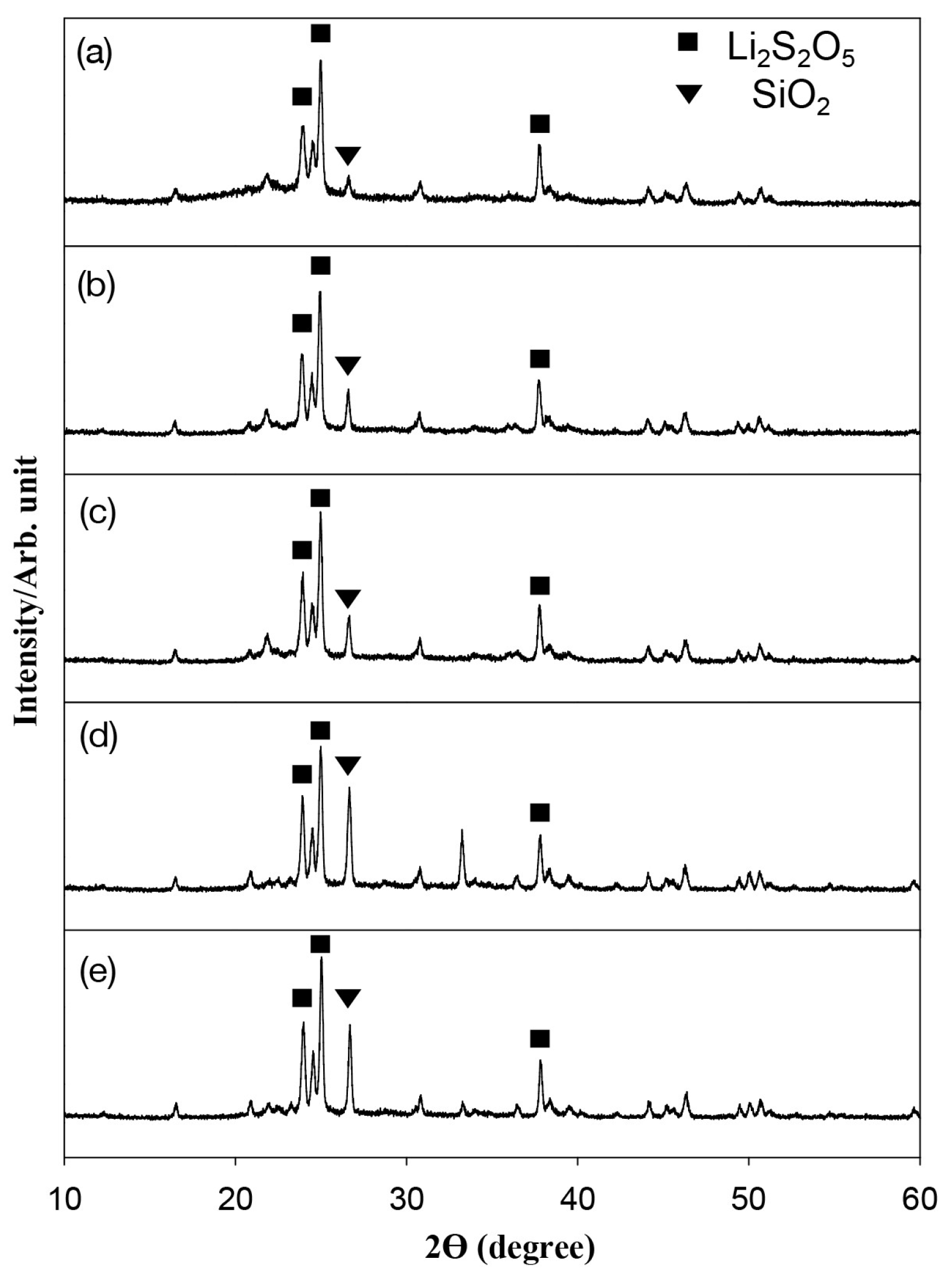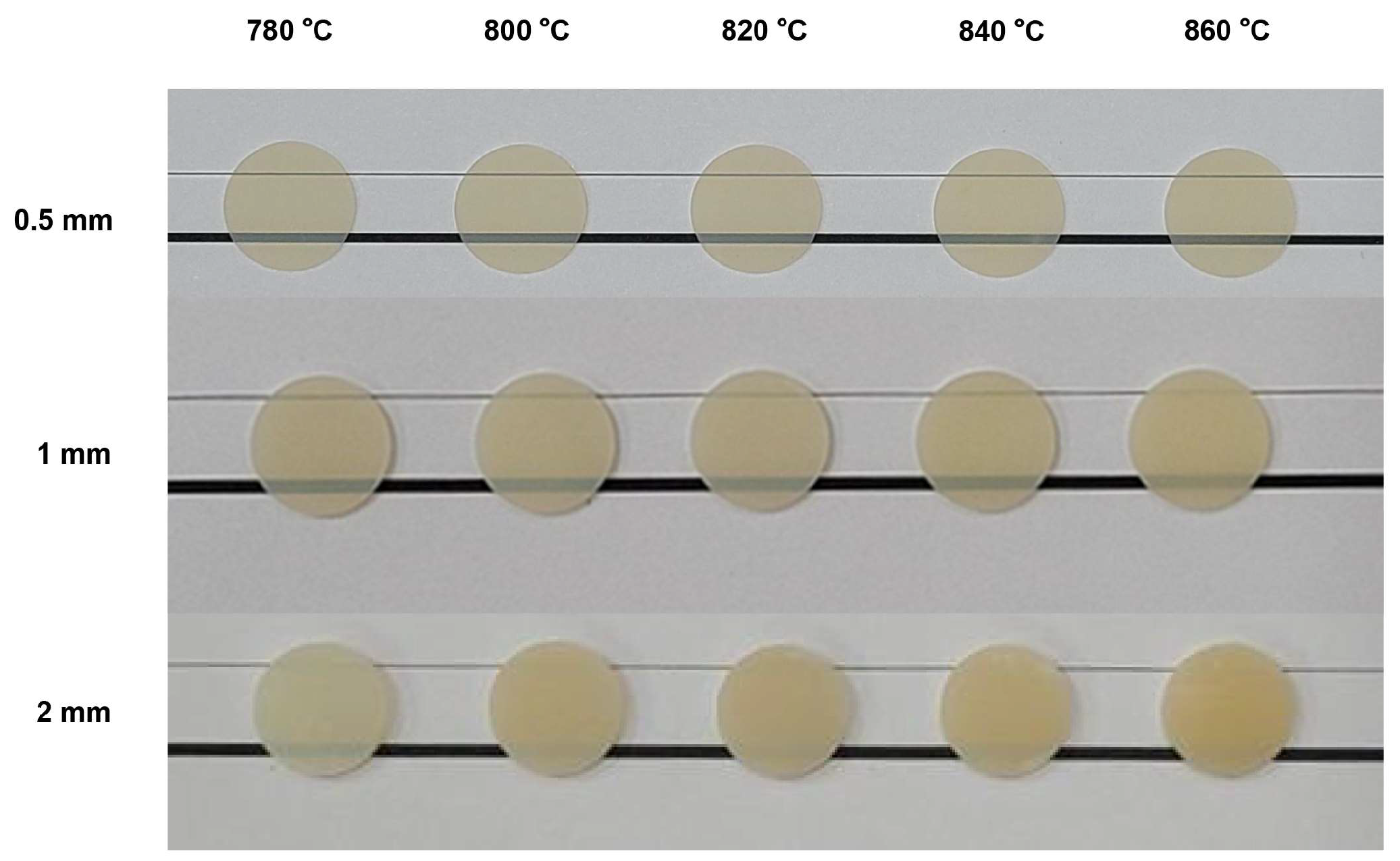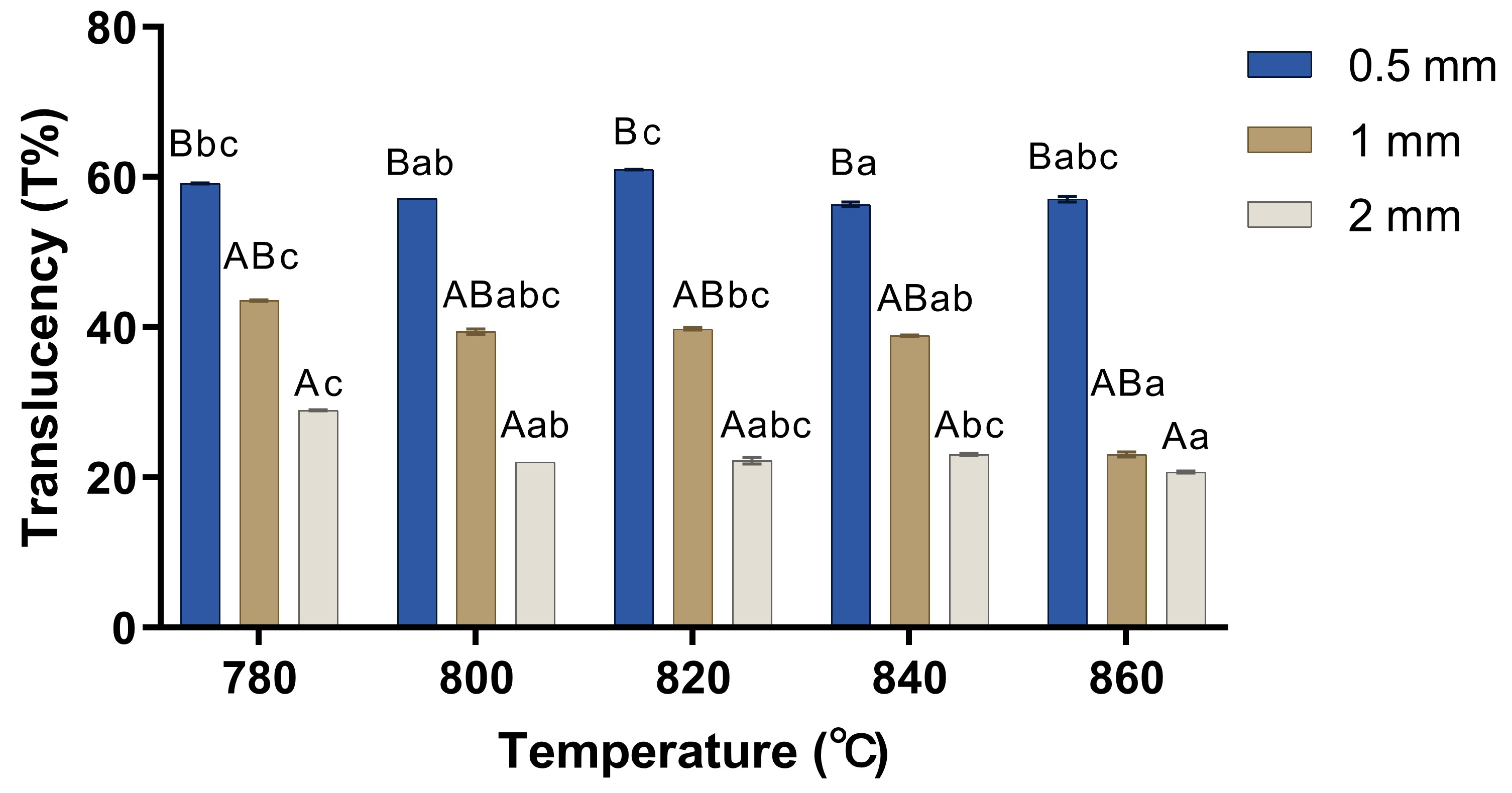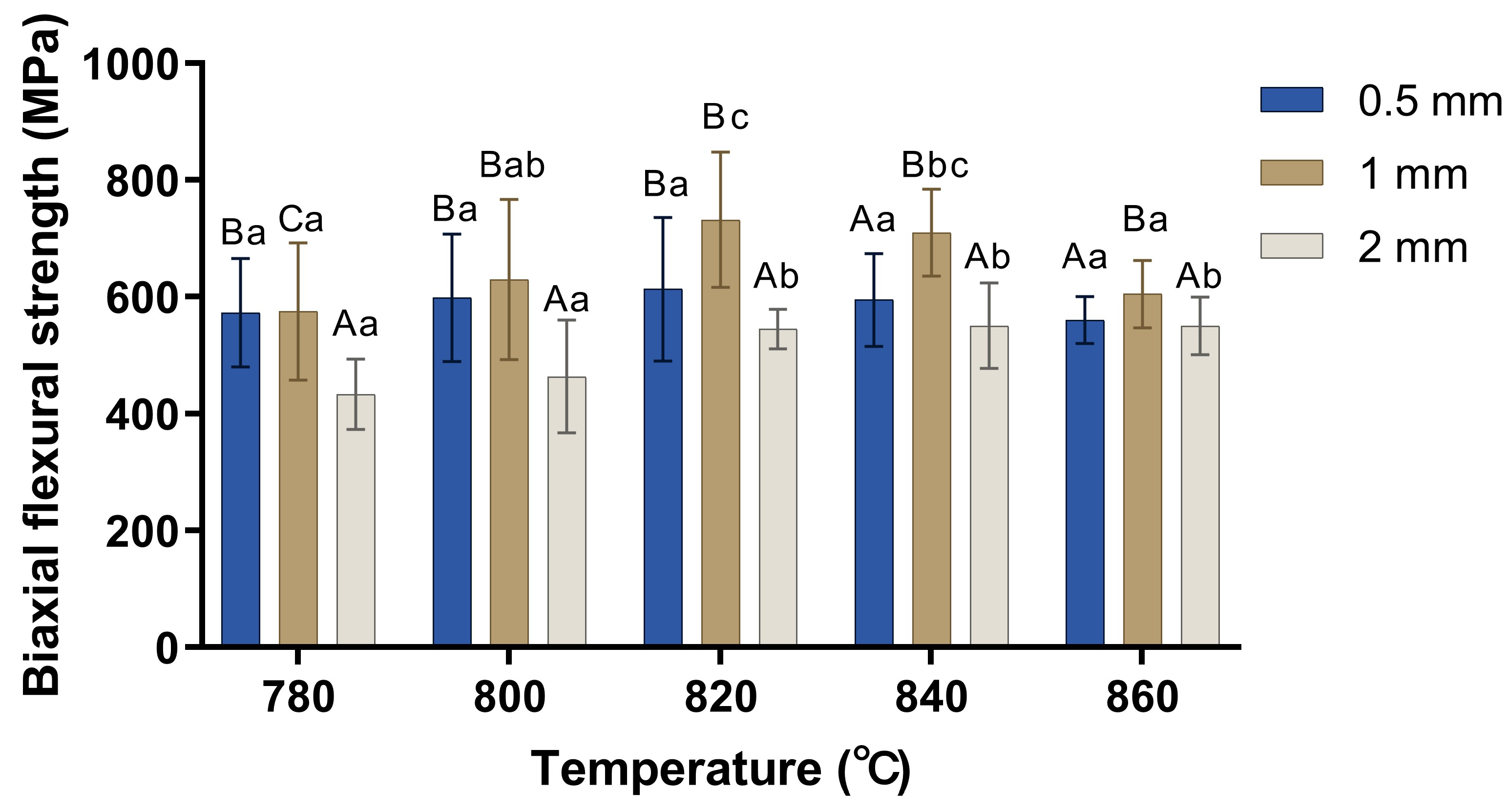Translucency and Strength of Lithium Disilicate for Computer-Aided Design and Manufacturing at Different Thermal Temperatures and Thicknesses: An In Vitro Study
Abstract
:1. Introduction
2. Materials and Methods
2.1. Glass Block Preparation
2.2. Heat-Treatment Schedule
2.3. X-ray Diffraction (XRD)
2.4. Translucency Measurement
2.5. Biaxial Flexural Strength
2.6. Statistical Analysis
3. Results
3.1. XRD Analysis
3.2. Translucency
3.3. Biaxial Flexural Strength
4. Discussion
5. Conclusions
Author Contributions
Funding
Institutional Review Board Statement
Informed Consent Statement
Data Availability Statement
Conflicts of Interest
References
- Willard, A.; Gabriel Chu, T.M. The science and application of IPS e. Max dental ceramic. Kaohsiung J. Med. Sci. 2018, 34, 238–242. [Google Scholar] [CrossRef]
- Hamza, T.A.; Sherif, R.M. Fracture Resistance of Monolithic Glass-Ceramics Versus Bilayered Zirconia-Based Restorations. J. Prosthodont. 2019, 28, e259–e264. [Google Scholar] [CrossRef] [PubMed]
- Rizzante, F.A.P.; Soares-Rusu, I.B.L.; Senna, S.S.; Ramos-Tonello, C.M.; Mondelli, R.F.L.; Ishikiriama, S.K.; Borges, A.F.S.; Gutmacher, Z. Flexural strength of minimum thickness ceramic veneers manufactured with different techniques. Quintessence Int. 2020, 51, 268–273. [Google Scholar] [PubMed]
- Lien, W.; Roberts, H.W.; Platt, J.A.; Vandewalle, K.S.; Hill, T.J.; Chu, T.M. Microstructural evolution and physical behavior of a lithium disilicate glass-ceramic. Dent. Mater. 2015, 31, 928–940. [Google Scholar] [CrossRef] [PubMed]
- Li, R.W.; Chow, T.W.; Matinlinna, J.P. Ceramic dental biomaterials and CAD/CAM technology: State of the art. J. Prosthodont. Res. 2014, 58, 208–216. [Google Scholar] [CrossRef] [PubMed]
- Bischoff, C.; Eckert, H.; Apel, E.; Rheinberger, V.M.; Höland, W. Phase evolution in lithium disilicate glass-ceramics based on non-stoichiometric compositions of a multi-component system: Structural studies by 29Si single and double resonance solid state, N.M.R. Phys. Chem. Chem. Phys. 2011, 13, 4540–4551. [Google Scholar] [CrossRef] [PubMed]
- Huang, S.; Cao, P.; Li, Y.; Huang, Z.; Gao, W. Nucleation and crystallization kinetics of a multicomponent lithium disilicate glass by in situ and real-time synchrotron X-ray diffraction. Cryst. Growth Des. 2013, 13, 4031–4038. [Google Scholar] [CrossRef]
- Jung, S.K.; Kim, D.W.; Lee, J.; Ramasamy, S.; Kim, H.S.; Ryu, J.J.; Shim, J.S. Modulation of lithium disilicate translucency through heat treatment. Materials 2021, 14, 2094. [Google Scholar] [CrossRef]
- Della Bona, A.; Nogueira, A.D.; Pecho, O.E. Optical properties of CAD-CAM ceramic systems. J. Dent. 2014, 42, 1202–1209. [Google Scholar] [CrossRef]
- Simba, B.G.; Ribeiro, M.V.; Alves, M.F.R.; Amarante, J.E.V.; Strecker, K.; dos Santos, C. Effect of the temperature on the mechanical properties and translucency of lithium silicate dental glass-ceramic. Ceram. Int. 2021, 47, 9933–9940. [Google Scholar] [CrossRef]
- Lindner, S.; Frasheri, I.; Hickel, R.; Crispin, A.; Kessler, A. Retrospective clinical study on the performance and aesthetic outcome of pressed lithium disilicate restorations in posterior teeth up to 8.3 years. Clin. Oral Investig. 2023, 27, 7383–7393. [Google Scholar] [CrossRef] [PubMed]
- Beall, G.H.; Duke, D.A. Transparent glass-ceramics. J. Mater. Sci. 1969, 4, 340–352. [Google Scholar] [CrossRef]
- Kim, J.H.; Ko, K.H.; Huh, Y.H.; Park, C.J.; Cho, L.R. Effects of the thickness ratio of zirconia-lithium disilicate bilayered ceramics on the translucency and flexural strength. J. Prosthodont. 2020, 29, 334–340. [Google Scholar] [CrossRef] [PubMed]
- Wang, F.; Takahashi, H.; Iwasaki, N. Translucency of dental ceramics with different thicknesses. J. Prosthet. Dent. 2013, 110, 14–20. [Google Scholar] [CrossRef]
- Dikicier, S.; Ayyildiz, S.; Ozen, J.; Sipahi, C. Influence of core thickness and artificial aging on the biaxial flexural strength of different all-ceramic materials: An in-vitro study. Dent. Mater. J. 2017, 36, 296–302. [Google Scholar] [CrossRef]
- Thompson, J.Y.; Anusavice, K.J.; Naman, A.; Morris, H.F. Fracture surface characterization of clinically failed all-ceramic crowns. J. Dent. Res. 1994, 73, 1824–1832. [Google Scholar] [CrossRef]
- ISO 6872:2015; Dentistry—Ceramic Materials. International Organization for Standardization (ISO): Geneva, Switzerland, 2015.
- Zhao, T.; Qin, Y.; Zhang, P.; Wang, B.; Yang, J.-F. High-performance, reaction sintered lithium disilicate glass–ceramics. Ceram. Int. 2014, 40, 12449–12457. [Google Scholar] [CrossRef]
- Barone, S.; Freulon, A.; Malard, B.; Dehmas, M. Solid-state phase transformation in a lithium disilicate-based glass-ceramic. J. Non-Cryst. Solids 2019, 513, 9–14. [Google Scholar] [CrossRef]
- Zhang, P.; Li, X.; Yang, J.; Xu, S. Effect of heat treatment on the microstructure and properties of lithium disilicate glass-ceramics. J. Non-Cryst. Solids 2014, 402, 101–105. [Google Scholar] [CrossRef]
- He, W.; Yao, C.; Zhao, Z.; Rong, C.; Zhang, Y.; Li, B.; Wu, X. Optimization of heat treatment program and effect of heat treatment on microstructure and flexural strength of micro-nano-Li2Si2O2 whisker-reinforced glass-ceramics. Front. Mater. 2023, 9, 1096276. [Google Scholar] [CrossRef]
- Antonson, S.A.; Anusavice, K.J. Contrast ratio of veneering and core ceramics as a function of thickness. Int. J. Prosthodont. 2001, 14, 316–320. [Google Scholar]
- Tuncel, İ.; Turp, I.; Üşümez, A. Evaluation of translucency of monolithic zirconia and framework zirconia materials. J. Adv. Prosthodont. 2016, 8, 181–186. [Google Scholar] [CrossRef]
- Zhao, T.; Lian, M.; Qin, Y.; Zhu, J.; Kong, X.; Yang, J. Improved performances of lithium disilicate glass-ceramics by seed induced crystallization. J. Adv. Ceram. 2021, 10, 614–626. [Google Scholar] [CrossRef]
- Zhang, Z.; Guo, J.; Sun, Y.; Tian, B.; Zheng, X.; Zhou, M.; He, L.; Zhang, S. Effects of crystal refining on wear behaviors and mechanical properties of lithium disilicate glass-ceramics. J. Mech. Behav. Biomed. Mater. 2018, 81, 52–60. [Google Scholar] [CrossRef] [PubMed]
- Serbena, F.C.; Zanotto, E.D. Internal residual stresses in glass-ceramics: A review. J. Non-Cryst. Solids 2012, 358, 975–984. [Google Scholar] [CrossRef]
- Serbena, F.C.; Mathias, I.; Foerster, C.E.; Zanotto, E.D. Crystallization toughening of a model glass-ceramic. Acta Mater. 2015, 86, 216–228. [Google Scholar] [CrossRef]
- Mastelaro, V.R.; Zanotto, E.D. Anisotropic residual stresses in partially crystallized Li2O–2SiO2 glass-ceramics. J. Non-Cryst. Solids 1999, 247, 79–86. [Google Scholar] [CrossRef]
- Li, D.; Guo, J.W.; Wang, X.S.; Zhang, S.F.; He, L. Effects of crystal size on the mechanical properties of a lithium disilicate glass-ceramic. Mater. Sci. Eng. A 2016, 669, 332–339. [Google Scholar] [CrossRef]
- Lewis, M.H.; Metcalf-Johansen, J.; Bell, P.S. Crystallization mechanisms in glass-ceramics. J. Am. Ceram. Soc. 1979, 62, 278–288. [Google Scholar] [CrossRef]
- Vichi, A.; Louca, C.; Corciolani, G.; Ferrari, M. Color related to ceramic and zirconia restorations: A review. Dent. Mater. 2011, 27, 97–108. [Google Scholar] [CrossRef]
- Vichi, A.; Zhao, Z.; Paolone, G.; Scotti, N.; Mutahar, M.; Goracci, C.; Louca, C. Factory crystallized silicates for monolithic metal-free restorations: A flexural strength and translucency comparison test. Materials 2022, 15, 7834. [Google Scholar] [CrossRef]
- Wen, G.; Zheng, X.; Song, L. Effects of P2O5 and sintering temperature on microstructure and mechanical properties of lithium disilicate glass-ceramics. Acta Mater. 2007, 55, 3583–3591. [Google Scholar] [CrossRef]
- Fabian Fonzar, R.; Carrabba, M.; Sedda, M.; Ferrari, M.; Goracci, C.; Vichi, A. Flexural resistance of heat-pressed and CAD-CAM lithium disilicate with different translucencies. Dent. Mater. 2017, 33, 63–70. [Google Scholar] [CrossRef]
- DeLong, R.; Douglas, W.H. Development of an artificial oral environment for the testing of dental restoratives: Bi-axial force and movement control. J. Dent. Res. 1983, 62, 32–36. [Google Scholar] [CrossRef] [PubMed]




| Temperature | 780 | 800 | 820 | 840 | 860 |
|---|---|---|---|---|---|
| Primary Grain Size | 28.4 ± 5.8 | 30.0 ± 1.9 | 32.7 ± 2.8 | 33.9 ± 1 | 35.5 ± 4 |
| Thickness (mm) | 0.5 | 1 | 2 | ||||
|---|---|---|---|---|---|---|---|
| 58.17 ± 1.76 c | 39.63 ± 2.37 b | 23.43 ± 2.96 a | |||||
| Temperature (°C) | 780 | 800 | 820 | 840 | 860 | ||
| 43.91 ± 13.09 a | 39.56 ± 15.19 a | 41.02 ± 16.79 a | 39.45 ± 14.42 a | 38.11 ± 15.77 a | |||
| Thickness (mm) | 0.5 | 1 | 2 | ||||
|---|---|---|---|---|---|---|---|
| 588.17 ± 92.87 b | 650.49 ± 118.8 c | 508.68 ± 81.66 a | |||||
| Temperature (°C) | 780 | 800 | 820 | 840 | 860 | ||
| 527.37 ± 113.23 a | 564.11 ± 134.43 ab | 630.24 ± 124.71 c | 618.65 ± 100.38 c | 571.87 ± 54.06 b | |||
Disclaimer/Publisher’s Note: The statements, opinions and data contained in all publications are solely those of the individual author(s) and contributor(s) and not of MDPI and/or the editor(s). MDPI and/or the editor(s) disclaim responsibility for any injury to people or property resulting from any ideas, methods, instructions or products referred to in the content. |
© 2024 by the authors. Licensee MDPI, Basel, Switzerland. This article is an open access article distributed under the terms and conditions of the Creative Commons Attribution (CC BY) license (https://creativecommons.org/licenses/by/4.0/).
Share and Cite
Li, C.-Y.; Jeong, K.-S.; Shin, J.-S.; Shim, J.-S.; Ryu, J.-J. Translucency and Strength of Lithium Disilicate for Computer-Aided Design and Manufacturing at Different Thermal Temperatures and Thicknesses: An In Vitro Study. Materials 2024, 17, 396. https://doi.org/10.3390/ma17020396
Li C-Y, Jeong K-S, Shin J-S, Shim J-S, Ryu J-J. Translucency and Strength of Lithium Disilicate for Computer-Aided Design and Manufacturing at Different Thermal Temperatures and Thicknesses: An In Vitro Study. Materials. 2024; 17(2):396. https://doi.org/10.3390/ma17020396
Chicago/Turabian StyleLi, Chong-Yang, Kyung-So Jeong, Jae-Seob Shin, Ji-Suk Shim, and Jae-Jun Ryu. 2024. "Translucency and Strength of Lithium Disilicate for Computer-Aided Design and Manufacturing at Different Thermal Temperatures and Thicknesses: An In Vitro Study" Materials 17, no. 2: 396. https://doi.org/10.3390/ma17020396





